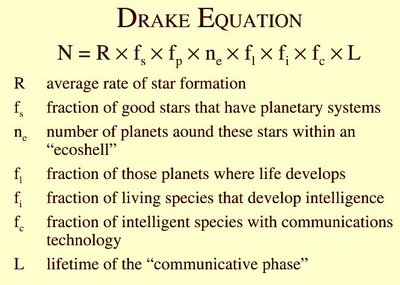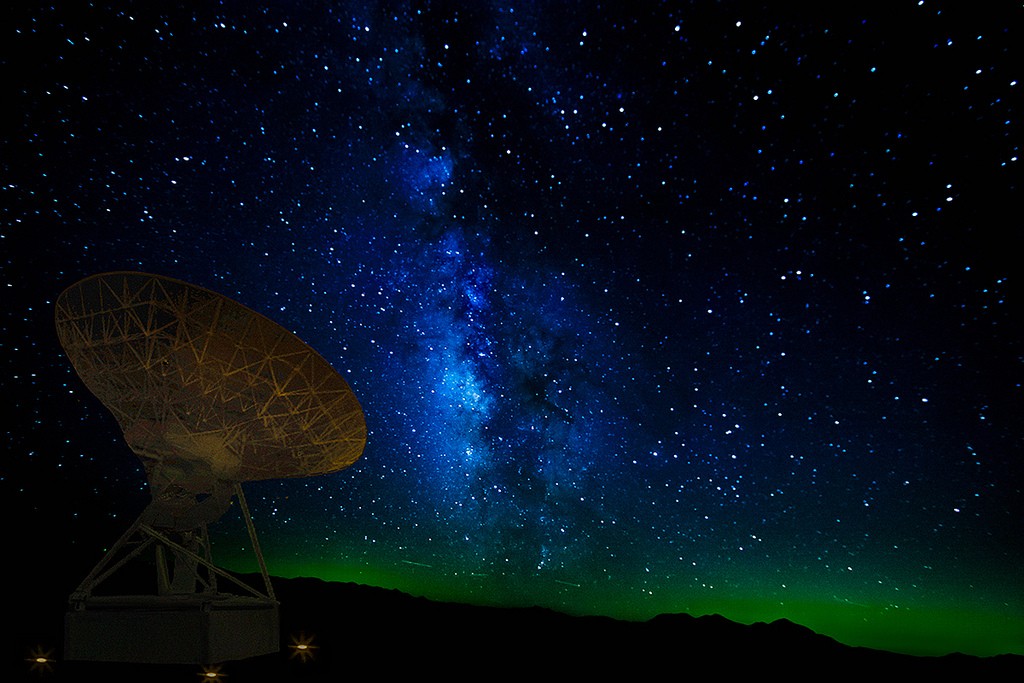One of the oldest questions our species has asked for thousands of years in written history and perhaps expressed verbally for who knows how long has been: are we alone in the universe?
Our current species homo-sapiens have been around for 200,000 years and other human species have also been around before and during those 200,000 years. Humans as a whole (considering all human species) have been around for about 2,500,000 years. We want to know what other advanced lifeforms are out there because we don’t want to be all alone on Earth in the vastness of the universe.
Introduction
When we look up into the night, we become mesmerized with the number of stars sparkling in the tapestry of the night sky. We are not only looking out at vast distances but back millions or even billions of years back in time. For the latter, you would need powerful telescopes unless if it’s something as powerful as a distant quasar, which are extremely bright violent distant galaxies exploding around a massive blackhole at the center of those galaxies (quasars are often used to measure vast distances between galaxies due to their bright nature). Otherwise, every star we see with the naked eye is in our galaxy only as everything beyond our galaxy is too faint for our eyes to pick it up.
We wonder what is out there. Are there beings like us out there? Can we meet them and learn about them? Maybe we can become friends to philosophize, argue with as friends do over a glass of expensive vintage wine, and discuss differences in culture. We simply want to be reassured that we are not alone.
We want to know that there is much more to life than we know. We want to share what we know about the universe, and we want to learn what they know. Perhaps we can work together as co-researchers to advance our understanding of science and ultimately our understanding of the universe.
If we can’t do that, even a “hello, we exist and come in peace. bye!” from them would suffice to change what it means to be human and alive in this world. Every future generation would dream and be inspired to somehow find a way to get to them and shake their hands as co-species. It would mean THE WORLD to us and hopefully them as well!
Drake Equation
One of the things most used to mathematically show life in the Milky Way Galaxy is Drake Equation, which was initially put together by astrophysicist Frank Drake in 1961. It is a 7 part equations, but unfortunately, last 4 of the pieces cannot even be estimated without finding signs of life away from Earth.
Many don’t consider this equation to be scientific as it currently relies too much on guess-work (I think the idea and parts are scientific but the data to fill out the equation are not more than our educated guesses).
Only the R and f(s) can currently be somewhat estimated. For R, NASA estimates 7 star formations per year (100 billion stars total) and for f(s), about 70% contain planets around them.
The best estimate for n(e), which is a reference to habitable zone that Drake refers to as ecoshell, is 17%. We have found quite a few planets in “goldilocks zone”, where liquid water and conditions for life can exist, in the last decade since we began looking using the Hubble telescope. Most recently, 8 new ones were found to be in goldilocks zone; there are many more habitable ones to be found every year. The other 4 parts of the equation are currently guesswork until we find signs of life elsewhere.
100 billion stars in Milky Way (R), 70% of them contain planets (f(s)), 17% of those are Earth-like (n(e)).. We are left with under 12 billion. Next question to explore: what percentage of those 12 billion planets have life?
Since intelligent life formed on Earth, the lowest N can be is 1, but mathematically there has to be more out there. The upper limit is impossible to say without more data. Due to that, I don’t want to focus more on this equation. Frank Drake’s original goal was for it to start a conversation and global debates, and that has been a success. Until we get more data or maybe receive signal from an alien species, we cannot do much more with it.
Why No Signals? Are we Alone?
There have been many efforts by SETI (Search for Extraterrestrial Intelligence) since 1985 to look for radio signals emitting from different regions of space, but to no success. Without communication, none of this matters. Why has there been no signal yet?
Of course, it is possible that it is all a pipe dream of mine. Maybe life doesn’t exist at all out there. Or if it does, maybe it is too spread out for us to have any chance of communicating with even the closest species within a reasonable time-frame. For instance, if the closest life is 500 light years away, it would take 500 years for their signal to reach us and 500 more years for us to send a signal back – I will discuss this a bit later. There are simply way too many obstacles to consider.
Another possibility is that those advanced beings maybe know about us or perhaps visited us already (if they figured out how to travel just under or somehow beyond the speed of light). They might have something like Star Trek’s ‘prime directive’, where they have strict regulations against showing themselves to primitive species like us. I talked about it briefly in a previous entry, but the idea is that if you are an advanced space-faring species, you don’t want another primitive species to rely on you for their well-being. If they are not philosophically evolved, they may use the technology they get from the advanced species for their own destruction. That would be blood on your hands or responsibility you cannot simply sustain without risking yourselves and risking what makes you be you. It’s not your job to change a species by bypassing their natural development because you would be picking-and-choosing what you want them to know. It could also lead to cultural shock among the lesser advanced species because they would meet an entirely different culture from different civilization, which could lead to inner-conflicts and more destruction to become like them. If we are very primitive (which we humans are), we are clearly not yet ready to meet a significantly more advanced species. Thus, they could easily cloak themselves from us.
The scariest possibility is that maybe an alien species already knows that we exist, know all about us, and tried to reach out to us multiple times, BUT we are simply too rudimentary (not advanced enough technologically or culturally) or too stupid to recognize a signal that has been right in front of us for centuries. Maybe they’re begging and praying to hear back from us, but we do not even know how to read their signal yet.
The last possibility scares the crap out of me. It’s like us trying to tell a chimp to use sign language without teaching the chimp how and what each sign means. Astrophysicist Neil deGrasse Tyson often says that we’re genetically 1% smarter than chimps, but within that 1%, the smartest chimp can make and use small sticks to fish out ants by putting the stick down an ant colony. At the same time, 1% smarter humans have complex languages, built the Hubble telescope, and works on quantum physics. In that 1% difference, chimps surely cannot directly communicate with us using anything beyond very basic sign language. Now imagine an alien species 1% smarter than us – Tyson poses the question how would WE communicate with THEM?

chimp fishing termites from termite colony / wiki
Where Do We Currently Stand?
Technologically and culturally, we are still a primitive species. Our civilization is still brand new as our species is about 200,000 years old, and we were hunter-gatherers using nothing but stone tools less than 15,000 years ago. First written language was not until around 5,500 years ago in the Sumer area in region of Mesopotamia (between Tigris and Euphrates Rivers). We came up with irrefutable evidence that the Earth revolves around the sun just 470 years ago thanks to Copernicus’ heliocentric model– Ancient Greeks proposed it before but Copernicus brought it back to life. About a century later, Galileo showed strong evidence for heliocentric model with observations using his telescope before Johannes Kepler essentially proved it by matching the measurements by his teacher & mentor Tycho Brahe with his own observations, math, and the other evidences that Galileo had collected. Newton later put a final death sentence to the geocentric model permanently with his law of universal gravitation. It took almost 2,000 years for us to prove the Earth is not at center of the universe and not until 1992 did the church finally admit that they were wrong all along for punishing Galileo over pushing the heliocentric model!
Just decades later, Newton published his 3 laws of motion in 1686 (329 years ago), and it was not until Einstein in 1915 that we understood how gravity warps and space-time continuum works on large macroscopic scale. Quantum physics (or mechanics, whatever you call it) began around that same time when we began to understand how differently particles behave on the small microscopic scale. On a time-scale, we just recently learned the absolute basics of our universe. Not until 1924 did Edwin Hubble show that Milky Way is just one of many galaxies.
SETI was not established until 1985 (30 years ago) to scan for radio signals, and Hubble telescope was launched in 1990 to scan distant stars. The first exoplanet was not found until 20 years ago (1995). We are just getting started!
Based on factors like distances, speed of light limitation, and how long we have been looking, I do not believe that we have been looking long enough. Thirty years is absolutely nothing to scan something as vast as the entire sky. Even if it was, we don’t even know what radio frequencies an alien species might use. Our only option is to search ALL frequencies. Perhaps an advanced species doesn’t even use radio frequencies, but some entirely different communication system we have yet to fathom!
That is where the entire problem enters a scale beyond our comprehension.
What is Our Current Best Hope?
Once we consider the difficulties and the limited amount of time we have been searching the sky with SETI, we begin to grasp how young of a species we truly are.
Considering the distances, I believe at the moment there are 4 possibilities we have of finding alien life:
1) they are in a nearby star-system, and they find us through our signals — assuming they are advanced somewhat beyond us in space technology — and we can communicate back-and-forth in reasonable time due to somewhat closer distances
2) they sent out a signal centuries ago in all directions, and signals reach us — we would not know if they’re still alive because they would have sent out the signal centuries ago before it reached us, and it would take centuries more for us to send a signal back. Thus, this would be generational communication with each generation unsure if a future one will get any reply, making it not reasonable
3) they have something like Star Trek’s warp drives that allow them to somehow travel beyond the speed of light to minimize the space & time factors. Einstein did say that nothing can travel beyond the speed of light BUT space can expand & contract faster than speed of light. Space can be contracted in front of a spaceship and expanded behind the spaceship causing forward propulsion beyond the speed of light (assuming there is some way to power it up and the spaceship can sustain extremely powerful vibrations). That, arguably, makes the warp drive theoretically possible, but that civilization would have to be faaaar advanced beyond us to have interstellar travel.
(cool image I found that depicts imaginary blueprints of Star Trek’s Enterprise)
4) they use some Faster-Than-Light (FTL) communication method that we have not thought of yet. Perhaps they can send us a traditional radio signal in which they teach us how to build a FTL communication system. Perhaps it uses a particle that we have only theorized, such as tachyons, which are hypothesized to travel faster than light. These particles would violate our current understanding of physics, but as I noted above, we are just in the infancy of our understanding of the universe. We just found the Higgs Boson only 3 years ago and still don’t have any idea what the heck dark matter is!
Considering the vastness of our galaxy, all 4 of these possibilities still require time and #3 and #4 are based entirely on theoretical possibilities that we don’t know if they’re realistically possible in the confines of physics.
Note: I have more to say, but I decided to split this blog entry here at 2,100 word count (I was hitting 3,000 words already so I just sliced out the rest for until next week). Next week, I will continue this by going into the implications of the theoretical possibilities and the biggest issues dealing with space (distances) and time in our search for extraterrestrial intelligence. All I will say is the numbers get pretty depressing as we realize how extremely difficult it is for a civilization to exist long enough for link up with another civilization.
- My Favorite Books - February 7, 2024
- Review of Carl Sagan’s The Demon-Haunted World - January 31, 2024
- The 75 Greatest Films of All Time - December 22, 2023







